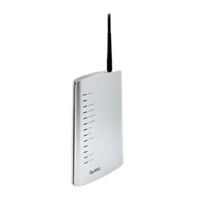ZyXEL Communications P-2602H-D7A Manuals
Manuals and User Guides for ZyXEL Communications P-2602H-D7A. We have 5 ZyXEL Communications P-2602H-D7A manuals available for free PDF download: User Manual, Firmware Release Notes, Quick Start Manual, Specifications, Declaration Of Conformity
ZyXEL Communications P-2602H-D7A User Manual (427 pages)
802.11g Wireless ADSL2+ VoIP IAD/ADSL2+ VoIP IAD
Brand: ZyXEL Communications
|
Category: Network Hardware
|
Size: 13.41 MB
Table of Contents
-
Preface35
-
-
Features38
-
-
Leds47
-
Table 4 Leds47
-
-
-
-
-
-
Introduction57
-
-
-
-
Introduction71
-
-
-
Introduction77
-
-
-
Any IP Table86
-
-
WAN Overview93
-
-
Enet Encap93
-
Pppoa94
-
Rfc 148394
-
-
Multiplexing94
-
VPI and VCI94
-
Nat95
-
-
Metric96
-
Traffic Redirect103
-
WAN Backup Setup105
-
-
-
LAN Overview107
-
Lan Tcp/Ip109
-
DHCP Setup115
-
LAN Client List116
-
LAN IP Alias117
-
-
-
-
No Security126
-
Wpa(2)-Psk128
-
-
OTIST Screen133
-
Notes on OTIST135
-
MAC Filter136
-
Qos Screen137
-
-
NAT Overview141
-
Port Forwarding145
-
-
Chapter 11 Voice
151-
Sip151
-
SIP Identities151
-
SIP Number151
-
-
SIP Servers152
-
-
Voice Coding156
-
156156
-
-
Phone164
-
-
The Flash Key168
-
-
Speed Dial172
-
-
-
Basics183
-
-
Traceroute187
-
-
-
Packet Filtering191
-
Firewall192
-
-
-
Access Methods193
-
-
Rule Checklist194
-
-
Action195
-
Service195
-
Source Address195
-
-
-
-
LAN to WAN Rules196
-
Alerts196
-
-
-
Dos Thresholds207
-
-
-
-
VPN Overview215
-
Ipsec215
-
-
Encryption215
-
Data Integrity216
-
-
VPN Applications216
-
-
Encapsulation217
-
Transport Mode218
-
Tunnel Mode218
-
Ipsec and NAT218
-
-
-
Ipsec Algorithms221
-
My IP Address222
-
VPN Setup Screen223
-
Keep Alive225
-
Pre-Shared Key229
-
IKE Phases234
-
Manual Key Setup239
-
-
-
Scheduler254
-
-
-
Www268
-
Telnet269
-
Configuring FTP270
-
Snmp271
-
Configuring DNS275
-
Configuring ICMP275
-
-
Upnp and Zyxel278
-
Chapter 24 Logs
295-
Logs Overview295
-
Alerts and Logs295
-
-
Viewing the Logs295
-
-
Chapter 25 Tools
301-
Introduction301
-
-
Restart307
-
-
-
-
-
-
Javascripts325
-
Java Permissions327
-
-
-
Windows 95/98/Me341
-
-
Macintosh os 8/9349
-
-
-
Macintosh os X350
-
Subnet Masks355
-
Subnetting355
-
-
-
Channel363
-
Rts/Cts363
-
Preamble Type365
-
IEEE 802.1X366
-
Radius366
-
Wpa369
-
-
-
Log Commands390
-
-
-
Command Syntax393
-
Command Usage393
-
Advertisement
ZyXEL Communications P-2602H-D7A Firmware Release Notes (36 pages)
Zyxel P-2602H-D1A: Release Note
Brand: ZyXEL Communications
|
Category: Network Router
|
Size: 0.23 MB
ZyXEL Communications P-2602H-D7A Quick Start Manual (7 pages)
P-2602H-D Series
Brand: ZyXEL Communications
|
Category: Network Router
|
Size: 0.35 MB
Table of Contents
Advertisement
ZyXEL Communications P-2602H-D7A Specifications (2 pages)
ADSL2+ VoIP IAD
Brand: ZyXEL Communications
|
Category: Network Router
|
Size: 0.25 MB
ZyXEL Communications P-2602H-D7A Declaration Of Conformity (1 page)
Zyxel P-2602H-D1A: Supplementary Guide
Brand: ZyXEL Communications
|
Category: Network Router
|
Size: 0.1 MB
Table of Contents
Advertisement
Related Products
- ZyXEL Communications P-2602H-D1A
- ZyXEL Communications P-2602H-D3A
- ZyXEL Communications P-2602HW-61C
- ZyXEL Communications P-2602HL-D1A
- ZyXEL Communications P-2602HL-D3A
- ZyXEL Communications P-2602HL
- ZyXEL Communications P-2602HWL-C -
- ZyXEL Communications P2602HW-C -
- ZyXEL Communications P-2602HWLNI-D3A
- ZyXEL Communications P-2602HW-63C




